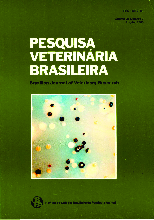 |
|
|
|
Year 2000 - Volume 20, Number 2
|

|
Identification of bovine virus diarrhea virus type-2 (BVDV-2) in southern Brazil, 20(2):85-89
|
ABSTRACT.- Flores E.F., Weiblen R., Scherer C.F.C., Gil L.H.V.G., Pilati C., Driemeier D., Moojen V. & Wendelstein A.C. 2000. [ldentification of bovine virus diarrhea virus type-2 (BVDV-2) in southern Brazil.] Identificação do vírus da diarréia viral bovina tipo 2 (BVDV-2) no sul do Brasil. Pesquisa Veterinária Brasileira 20(2):85-89. Depto Medicina Veterinária Preventiva, Universidade Federal de Santa Maria, 97105-900 Santa Maria, RS, Brazil.
Highly virulent bovine viral diarrhea virus (BVDV) isolates, named BVDV type-2 (BVDV-2), were initially identified in outbreaks of acute and hemorrhagic BVD and have been previously isolated mainly in North America. The present article describes two cases of gastroenteric/respiratory disease in southern Brazil from which BVDV type 2 viruses were isoiated. The. viruses were isolated from two heifers belonging to different herds. One animal developed na acute disease, characterized by anorexia, ruminal atony, dark to bloody diarrhea, tenesmo and mucopurulent nasal discharge. The other animal developed a long lasting disease (7 months), characterized by retarded growth, anorexia, recurrent episodes of diarrhea, interdigital dermatitis, occasional digestive and genital bleeding, conjuntivitis, arthritis and chronic pneumonia. Disseminated mucosal congestion, extensive and deep ulcerations in the tangue, palate and esophagus, necrotic areas in.the ruminal mucosa, areas of congestion covered with fibrin in the small intestine were the most prominent findings. BVDV antigens were detected by immunohistochemístry in the tangue epithelium, lungs and in mesenteric lymph nades. Non-cytopathic BVD viruses were isolated from white blood cells and spleen from the affected animals through inoculation of cultured cells and demonstration of viral antigens by immunofluorescence. Subsequently, antigenic characterization and phylogenetic analysis of these - plus two BVD viruses that have been isolated from healthy fetuses – allowed their classification into the genotype 2. The presence of BVDV-2 among Brazilian cattle is epidemiologically relevant and may have important implications for diagnosis, immunization strategies and vaccine production. |
| |
|
|
| |
|
 |